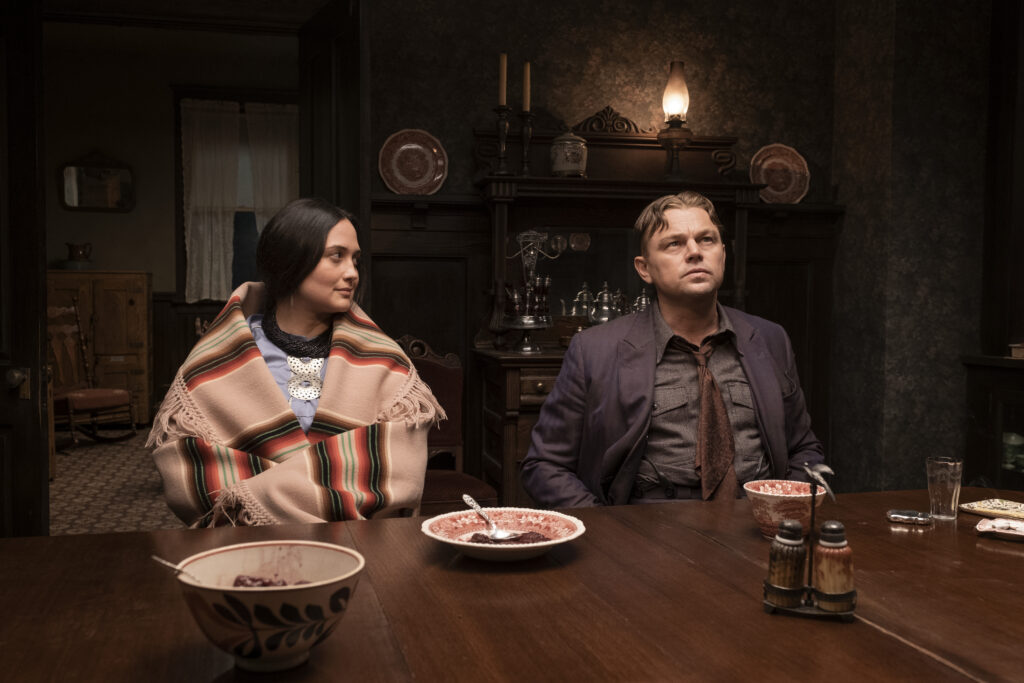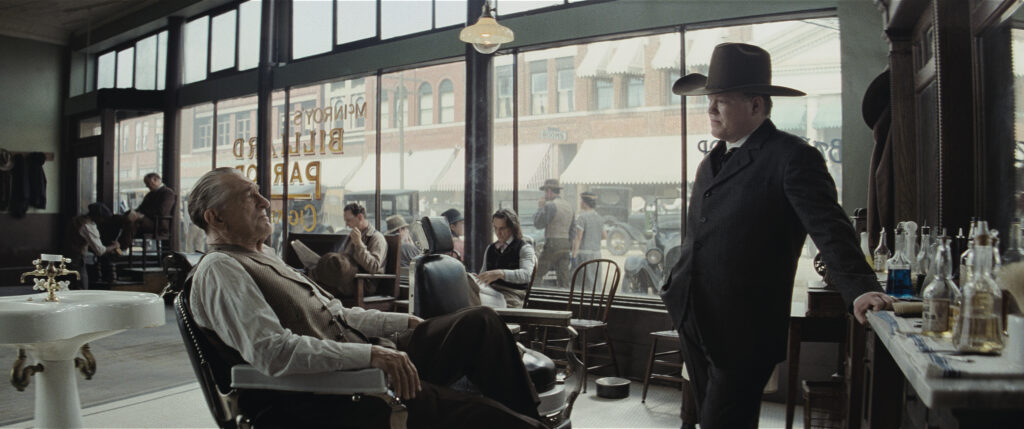October 19, 2023
by Carla Hay

Directed by Martin Scorsese
Some language in Dhegiha Siouan with no subtitles
Culture Representation: Taking place in Oklahoma, from 1919 to 1926, the dramatic film “Killers of the Flower Moon” (based on the non-fiction book of the same name) features a white and Native American cast of characters representing the working-class, middle-class and wealthy.
Culture Clash: World War I veteran Ernest Burkhart gets caught up in murders of members of the Osage Nation, including family members of his Osage Nation wife, who are being killed to gain possession of land that is rich in petroleum oil.
Culture Audience: “Killers of the Flower Moon” will appeal primarily to people who are fans of filmmaker Martin Scorsese, the star headliners and history-based movies with a top-notch principal cast.

Epic in scope and tragic in tone, “Killers of the Flower Moon” is an impactful drama that tells the true story of a shameful part of American history when racism and greed caused the murders of Osage Nation people. The movie is very long but worth seeing. At 206 minutes (nearly three-and-a-half hours), “Killers of the Flower Moon” has moments when the pacing tends to drag. However, the movie is impressive in almost every other way.
Oscar-winning filmmaker Martin Scorsese directed “Killers of the Flower Moon” from a screenplay that he co-wrote with Eric Roth. The screenplay was adapted from David Grann’s 2017 non-fiction book “Killers of the Flower Moon: The Osage Murders and the Birth of the FBI.” “Killers of the Flower Moon” had its world premiere at the 2023 Cannes Film Festival.
“Killers of the Flower Moon” (which takes place in Oklahoma from 1919 to 1926) is fairly straightforward in showing what it’s about early on the story. World War I veteran Ernest Burkhart (played by Leonardo DiCaprio) arrives in the city of Fairfax, Oklahoma, to start a new chapter in his life. Ernest was wounded in the war, so his job opportunities are limited.
Ernest begins working for his cattle-farming uncle William “Bill” Hale, also known as King Hale, who is one of the most powerful and corrupt people in the city. Bill, who is also Farifax’s deputy sheriff, has a fake persona of being an upstanding and lawful citizen. Fairfax and the surrounding cities have a lot of petroleum-rich land that is owned by the Osage Nation tribe of Native Americans/indigenous people, who have a complicated and often uneasy co-existence with the white people who live in the same cities.
Soon after bachelor Ernest arrives in Fairfax, Bill asks him what kind of women appeal to Ernest. Ernest says he likes all types of women and is open to romancing women of Native American heritage. Bill tells Ernest that it would be to Ernest’s financial advantage if he marries and has children with an Osage Nation woman, in order for Ernest to get control of some of the Osage Nation land that can make the owners wealthy from the petroleum oil mined from the land.
There’s a very sinister aspect to this inheritance-by-marriage scheme: Osage Nation people in the area have been dying in alarming numbers in the region. Many of these deaths look like accidents or suicides but are actually murders. This period of time was called the Reign of Terror.
The local law enforcement controlled by white people are doing little to nothing to investigate these deaths and hinder any investigations from Osage Nation officers. It isn’t long before Ernest gets involved in these murders. None of this is spoiler information, since “Killers of the Flower Moon” is a history-based drama.
At Bill’s urging, Ernest begins courting an Osage Nation woman named Mollie Kyle (played by Lily Gladstone), who has hired Ernest to be her driver. Mollie is the movie’s frequent voiceover narrator. Ernest and Mollie have a mild flirtation that quickly grows into mutual sexual attraction. Mollie genuinely falls in love with Ernest. Meanwhile, Ernest seems to have romantic feelings for Mollie, but he’s more in love with what he can get out of this marriage. After a quick courtship, Mollie and Ernest get married and they have children together.
At the time that Mollie and Ernest get married (she changes her last name to Burkhart), her family consists mostly of women. Mollie’s widowed mother Lizzie Q (played by Tantoo Cardinal) suspects that white people are murdering Osage Nation people, so she doesn’t trust white people, and she disapproves of Mollie’s marriage to Ernest. Mollie’s sister Reta (played by Janae Collins) is married to a white man named Bill Smith (played Jason Isbell), who was previously married to Mollie’s other sister Minnie (played by Jillian Dion), who died of a “wasting illness.” Mollie has another sister named Anna (played by Cara Jade Myers), who is feisty and who likes to party.
Other people who are connected in some way to the murders and/or the investigations include Federal Bureau of Investigation official Tom White (played by Jesse Plemons); Osage Nation Chief Bonnicastle (played by Yancey Red Corn); and a lowlife thug named Kelsie Morris (played by Louis Cancelmi), who works closely with Bill. Other supporting actors in the movie include John Lithgow as Prosecutor Peter Leaward and Brendan Fraser as defense attorney W.S. Hamilton. Fraser’s over-the-top performance verges on being campy and doesn’t quite fit the more grounded and somber tone of the movie.
A valid criticism of “Killers of the Flower Moon” is it that the Osage Nation people in the movie aren’t the center of the story and should have been given more screen time and better character development. Except for Mollie and her Osage Nation family members, Osage Nation people are primarily depicted in the movie has having vague or non-existent personalities. Without Mollie and her family, “Killers of the Flower Moon” would be a largely soulless portrayal of hate crimes and racial injustice.
“Killers of the Flower Moon” accurately shows that the wealthy Osage Nation people couldn’t get access to their money without getting permission from the white government officials (in this case, all white men) who controlled the Osage Nation’s finances. Ironically, similar dynamics exist in the film industry, in terms of who usually gets to tell stories about Native American people in big-budget movies. (Not much has changed since the Oscar-winning blockbuster success of 1990’s “Dances With Wolves.”) It’s unlikely that Native American filmmakers—no matter how talented or experienced—would have been given the same privileges or budget to tell this story as the all-white team of producers, screenwriters and director who made “Killers of the Flower Moon.”
One of the more fascinating aspects of “Killers of the Flower Moon” is how the personalities of Ernest and Mollie change during the period of time when this story takes place. At first, Ernest appears to be somewhat of an easily led buffoon who doesn’t seem to know much about life. Over time, Ernest shows that he’s much more manipulative and cunning than he first appears to be. He’s the type of schemer whose loyalties to anyone except himself are very murky, questionable, and can quickly shift to suit his own agenda.
Mollie starts off being confident and outspoken, with more power in the relationship. After all, she was Ernest’s boss when they began their courtship. However, as time goes on, after Mollie and Ernest are married, she becomes worn down and insecure by tragedy and illness. (Mollie, who has diabetes, is being slowly poisoned by tainted insulin without her knowledge.) Mollie’s unconditional love for Ernest also blinds her to the dark side of his personality, so she becomes too trusting of what he’s saying and doing.
The movie tries to push a narrative that Ernest is a loving father and husband who’s conflicted about his ulterior motives. However, during the latter half of the film, there’s no doubt about what type of husband Ernest is, because of his knowledge about why Mollie is slowly dying. Ernest is also not shown having a close bond with his and Mollie’s children (Elizabeth, Cowboy, and Anna), who are all under the age of 7, and are mostly background characters.
Vanessa Rose Pham has the role of Elizabeth as a baby. Kinsleigh McNac has the role of Elizabeth at ages 2 and 3. Elizabeth Waller has the role of Elizabeth at ages 3 to 5 years old. Alexis Waller has the role of Elizabeth at ages 5 and 6. Roanin Davis has the role of Cowboy as a baby. Bravery Lane Nowlin has the role of Cowboy at ages 2 and 3. Mamie Cozad has the role of Anna as a baby. Lux Britni Malaske has the role of Anna at 2 years old.
“Killers of the Flower Moon” is not a murder mystery, because it’s revealed very early on in the story who are the main perpetrators of these crimes. The movie is more of a chronicle of systemic racism and how it leads to incalculable damage that goes beyond city borders. The story is told through the lens of the relationship between Mollie and Ernest as a way for viewers to see how one particular family was affected by evil disguised as entitlement.
On a technical level, “Killers of the Flower Moon” is nearly flawless, when it comes to cinematography, production design, costume design and musical score. (Robbie Robertson, the composer for “Killers of the Flower Moon,” passed away in August 2023.) “Killers of the Flower Moon” succeeds in immersing viewers into this particular community where “truth” and “justice” can be warped and have different meanings to people.
People who watch “Killers of the Flower Moon” can expect the usual excellence from the principal cast members, although there’s a lot of familiarity to DiCaprio and De Niro portraying dishonorable characters in Scorsese movies, as they have done so many times already. Gladstone has the breakout performance in “Killers of the Flower Moon,” since her depiction of Mollie is absolutely superb. Although the Reign of Terror involved many people in several regions, “Killers of the Flower Moon,” along with Gladstone’s performance, shows with disturbing clarity the horror of a duplicitous serial killer as a trusted member of one’s own household.
Apple Studios and Paramount Pictures will release “Killers of the Flower Moon” in U.S. cinemas on October 20, 2023.

